Tabular Data with Pandas¶
Pandas is the most popular Python tool for data analysis. It handles tabular data and has tons of nice features for manipulating text, grouping data by attributes, formatting dates, the list goes on… Even if you do not use tabular or csv data, you will likely end up using Pandas tools for some of their nice data-wrangling features. In general, if you have data that could be organized in an Excel spreadsheet or a table, you should use Pandas. This is particularly useful for data downloaded from places like NOAA and USGS where observations from individual meaurement stations are usually concatenated into a table of some kind. Pandas can be used to open data in CSV, HTML, JSON, XLS, Parquet, SQL, GBQ formats and more.
Earthquake Data Tutorial¶
For this tutorial we have grabbed the last 30 days of global earthquake activity from USGS (downloaded August 11th, 2025). The data only includes earthquakes of magnitude greater than or equal to 2.5.
[1]:
import pandas as pd #import the pandas library
# open our csv file, this assumes it is in the top level of your VSCode workspace
df = pd.read_csv('global_30day_earthquakes.csv')
When we open a dataset, Pandas reads the data into an object called a ‘DataFrame’ which looks like a table.
[2]:
# inspect our dataframe
df
[2]:
| time | latitude | longitude | depth | mag | magType | nst | gap | dmin | rms | ... | updated | place | type | horizontalError | depthError | magError | magNst | status | locationSource | magSource | |
|---|---|---|---|---|---|---|---|---|---|---|---|---|---|---|---|---|---|---|---|---|---|
| 0 | 2025-08-12T00:30:58.784Z | 62.008000 | -145.533400 | 9.800 | 2.60 | ml | NaN | NaN | NaN | 0.8700 | ... | 2025-08-12T00:37:39.629Z | 7 km SW of Copperville, Alaska | earthquake | NaN | 0.300 | NaN | NaN | automatic | ak | ak |
| 1 | 2025-08-12T00:30:53.834Z | 61.740900 | -146.097200 | 42.400 | 2.60 | ml | NaN | NaN | NaN | 0.5700 | ... | 2025-08-12T00:35:35.397Z | 38 km S of Tolsona, Alaska | earthquake | NaN | 3.200 | NaN | NaN | automatic | ak | ak |
| 2 | 2025-08-11T23:45:41.896Z | 51.193700 | 160.859900 | 10.000 | 4.50 | mb | 25.0 | 135.00 | 2.2830 | 0.4400 | ... | 2025-08-12T00:10:36.040Z | 256 km SE of Vilyuchinsk, Russia | earthquake | 7.30 | 1.883 | 0.069 | 61.0 | reviewed | us | us |
| 3 | 2025-08-11T21:24:31.503Z | 41.242100 | -116.714900 | 6.300 | 2.90 | ml | 14.0 | 144.57 | 0.3420 | 0.1627 | ... | 2025-08-11T22:14:22.638Z | 60 km NE of Valmy, Nevada | earthquake | NaN | 3.300 | 0.260 | 12.0 | reviewed | nn | nn |
| 4 | 2025-08-11T21:02:42.456Z | 51.651500 | 159.778700 | 35.000 | 5.00 | mb | 61.0 | 106.00 | 1.5390 | 0.6000 | ... | 2025-08-12T00:35:51.040Z | 170 km SSE of Vilyuchinsk, Russia | earthquake | 6.76 | 1.859 | 0.043 | 175.0 | reviewed | us | us |
| ... | ... | ... | ... | ... | ... | ... | ... | ... | ... | ... | ... | ... | ... | ... | ... | ... | ... | ... | ... | ... | ... |
| 2658 | 2025-07-13T03:02:17.889Z | -22.593300 | -68.014400 | 153.524 | 4.40 | mb | 29.0 | 89.00 | 0.3880 | 0.8700 | ... | 2025-08-02T22:30:27.040Z | 40 km NNE of San Pedro de Atacama, Chile | earthquake | 7.46 | 5.557 | 0.138 | 15.0 | reviewed | us | us |
| 2659 | 2025-07-13T02:32:49.570Z | 32.791833 | -115.829333 | 4.810 | 2.62 | ml | 67.0 | 28.00 | 0.1032 | 0.2600 | ... | 2025-08-02T22:22:55.040Z | 17 km ENE of Ocotillo, CA | earthquake | 0.20 | 0.640 | 0.121 | 131.0 | reviewed | ci | ci |
| 2660 | 2025-07-13T00:49:42.340Z | -9.885400 | 116.631100 | 54.034 | 4.10 | mb | 17.0 | 104.00 | 1.5440 | 0.4500 | ... | 2025-07-25T02:12:15.040Z | 128 km S of Taliwang, Indonesia | earthquake | 8.08 | 5.198 | 0.174 | 9.0 | reviewed | us | us |
| 2661 | 2025-07-13T00:30:59.994Z | 50.336900 | -175.400000 | 10.000 | 2.80 | ml | 19.0 | 235.00 | 1.6530 | 0.7300 | ... | 2025-07-22T21:41:02.040Z | 191 km SSE of Adak, Alaska | earthquake | 3.57 | 2.019 | 0.105 | 12.0 | reviewed | us | us |
| 2662 | 2025-07-13T00:11:12.440Z | -49.427300 | -8.066900 | 10.000 | 4.50 | mb | 14.0 | 106.00 | 22.4470 | 0.6600 | ... | 2025-07-25T01:58:47.040Z | southern Mid-Atlantic Ridge | earthquake | 8.85 | 1.934 | 0.145 | 14.0 | reviewed | us | us |
2663 rows × 22 columns
[3]:
# instead of looking at the whole table, lets see an overview of the information we have
df.info()
<class 'pandas.core.frame.DataFrame'>
RangeIndex: 2663 entries, 0 to 2662
Data columns (total 22 columns):
# Column Non-Null Count Dtype
--- ------ -------------- -----
0 time 2663 non-null object
1 latitude 2663 non-null float64
2 longitude 2663 non-null float64
3 depth 2663 non-null float64
4 mag 2663 non-null float64
5 magType 2663 non-null object
6 nst 2498 non-null float64
7 gap 2496 non-null float64
8 dmin 2496 non-null float64
9 rms 2662 non-null float64
10 net 2663 non-null object
11 id 2663 non-null object
12 updated 2663 non-null object
13 place 2663 non-null object
14 type 2663 non-null object
15 horizontalError 2481 non-null float64
16 depthError 2662 non-null float64
17 magError 2470 non-null float64
18 magNst 2478 non-null float64
19 status 2663 non-null object
20 locationSource 2663 non-null object
21 magSource 2663 non-null object
dtypes: float64(12), object(10)
memory usage: 457.8+ KB
We can see that the column ‘time’ has been recognized as a generic object, instead of a date. Let’s fix that by telling Pandas which column to interpret as a date type. The list above tells us that the date is the 0th column.
[4]:
df = pd.read_csv('global_30day_earthquakes.csv', parse_dates=[0])
When we run df.info() again, we can see that time is now a datetime64 type. We can also see that the datetime units are nanoseconds, and that it is UTC time. One of the best features of Pandas is the ease with which it can handle and interpret dates.
[5]:
df.info()
<class 'pandas.core.frame.DataFrame'>
RangeIndex: 2663 entries, 0 to 2662
Data columns (total 22 columns):
# Column Non-Null Count Dtype
--- ------ -------------- -----
0 time 2663 non-null datetime64[ns, UTC]
1 latitude 2663 non-null float64
2 longitude 2663 non-null float64
3 depth 2663 non-null float64
4 mag 2663 non-null float64
5 magType 2663 non-null object
6 nst 2498 non-null float64
7 gap 2496 non-null float64
8 dmin 2496 non-null float64
9 rms 2662 non-null float64
10 net 2663 non-null object
11 id 2663 non-null object
12 updated 2663 non-null object
13 place 2663 non-null object
14 type 2663 non-null object
15 horizontalError 2481 non-null float64
16 depthError 2662 non-null float64
17 magError 2470 non-null float64
18 magNst 2478 non-null float64
19 status 2663 non-null object
20 locationSource 2663 non-null object
21 magSource 2663 non-null object
dtypes: datetime64[ns, UTC](1), float64(12), object(9)
memory usage: 457.8+ KB
We can inspect the first few entries with df.head()
[6]:
df.head()
[6]:
| time | latitude | longitude | depth | mag | magType | nst | gap | dmin | rms | ... | updated | place | type | horizontalError | depthError | magError | magNst | status | locationSource | magSource | |
|---|---|---|---|---|---|---|---|---|---|---|---|---|---|---|---|---|---|---|---|---|---|
| 0 | 2025-08-12 00:30:58.784000+00:00 | 62.0080 | -145.5334 | 9.8 | 2.6 | ml | NaN | NaN | NaN | 0.8700 | ... | 2025-08-12T00:37:39.629Z | 7 km SW of Copperville, Alaska | earthquake | NaN | 0.300 | NaN | NaN | automatic | ak | ak |
| 1 | 2025-08-12 00:30:53.834000+00:00 | 61.7409 | -146.0972 | 42.4 | 2.6 | ml | NaN | NaN | NaN | 0.5700 | ... | 2025-08-12T00:35:35.397Z | 38 km S of Tolsona, Alaska | earthquake | NaN | 3.200 | NaN | NaN | automatic | ak | ak |
| 2 | 2025-08-11 23:45:41.896000+00:00 | 51.1937 | 160.8599 | 10.0 | 4.5 | mb | 25.0 | 135.00 | 2.283 | 0.4400 | ... | 2025-08-12T00:10:36.040Z | 256 km SE of Vilyuchinsk, Russia | earthquake | 7.30 | 1.883 | 0.069 | 61.0 | reviewed | us | us |
| 3 | 2025-08-11 21:24:31.503000+00:00 | 41.2421 | -116.7149 | 6.3 | 2.9 | ml | 14.0 | 144.57 | 0.342 | 0.1627 | ... | 2025-08-11T22:14:22.638Z | 60 km NE of Valmy, Nevada | earthquake | NaN | 3.300 | 0.260 | 12.0 | reviewed | nn | nn |
| 4 | 2025-08-11 21:02:42.456000+00:00 | 51.6515 | 159.7787 | 35.0 | 5.0 | mb | 61.0 | 106.00 | 1.539 | 0.6000 | ... | 2025-08-12T00:35:51.040Z | 170 km SSE of Vilyuchinsk, Russia | earthquake | 6.76 | 1.859 | 0.043 | 175.0 | reviewed | us | us |
5 rows × 22 columns
We can see above that each entry gets a generic row index of 0, 1, 2,… That isn’t particularly useful for our analysis since the indices don’t mean anything physical. Let’s change that by telling Pandas which column to use as the index. In this case we will use the earthquake ID. These are unique alphanumeric strings assigned by USGS to each earthquake.
[7]:
df = df.set_index('id')
df.head()
[7]:
| time | latitude | longitude | depth | mag | magType | nst | gap | dmin | rms | ... | updated | place | type | horizontalError | depthError | magError | magNst | status | locationSource | magSource | |
|---|---|---|---|---|---|---|---|---|---|---|---|---|---|---|---|---|---|---|---|---|---|
| id | |||||||||||||||||||||
| ak025aagkam9 | 2025-08-12 00:30:58.784000+00:00 | 62.0080 | -145.5334 | 9.8 | 2.6 | ml | NaN | NaN | NaN | 0.8700 | ... | 2025-08-12T00:37:39.629Z | 7 km SW of Copperville, Alaska | earthquake | NaN | 0.300 | NaN | NaN | automatic | ak | ak |
| ak025aagka93 | 2025-08-12 00:30:53.834000+00:00 | 61.7409 | -146.0972 | 42.4 | 2.6 | ml | NaN | NaN | NaN | 0.5700 | ... | 2025-08-12T00:35:35.397Z | 38 km S of Tolsona, Alaska | earthquake | NaN | 3.200 | NaN | NaN | automatic | ak | ak |
| us6000qzzz | 2025-08-11 23:45:41.896000+00:00 | 51.1937 | 160.8599 | 10.0 | 4.5 | mb | 25.0 | 135.00 | 2.283 | 0.4400 | ... | 2025-08-12T00:10:36.040Z | 256 km SE of Vilyuchinsk, Russia | earthquake | 7.30 | 1.883 | 0.069 | 61.0 | reviewed | us | us |
| nn00902440 | 2025-08-11 21:24:31.503000+00:00 | 41.2421 | -116.7149 | 6.3 | 2.9 | ml | 14.0 | 144.57 | 0.342 | 0.1627 | ... | 2025-08-11T22:14:22.638Z | 60 km NE of Valmy, Nevada | earthquake | NaN | 3.300 | 0.260 | 12.0 | reviewed | nn | nn |
| us6000qzz1 | 2025-08-11 21:02:42.456000+00:00 | 51.6515 | 159.7787 | 35.0 | 5.0 | mb | 61.0 | 106.00 | 1.539 | 0.6000 | ... | 2025-08-12T00:35:51.040Z | 170 km SSE of Vilyuchinsk, Russia | earthquake | 6.76 | 1.859 | 0.043 | 175.0 | reviewed | us | us |
5 rows × 21 columns
We can investigate specific columns of the first 10 entries with the following syntax:
[8]:
df[['place', 'mag','depth']].head(n=10)
[8]:
| place | mag | depth | |
|---|---|---|---|
| id | |||
| ak025aagkam9 | 7 km SW of Copperville, Alaska | 2.6 | 9.800 |
| ak025aagka93 | 38 km S of Tolsona, Alaska | 2.6 | 42.400 |
| us6000qzzz | 256 km SE of Vilyuchinsk, Russia | 4.5 | 10.000 |
| nn00902440 | 60 km NE of Valmy, Nevada | 2.9 | 6.300 |
| us6000qzz1 | 170 km SSE of Vilyuchinsk, Russia | 5.0 | 35.000 |
| us6000qzyh | 195 km SE of Vilyuchinsk, Russia | 4.8 | 10.000 |
| us6000qzvz | 94 km NW of Copiapó, Chile | 4.8 | 23.635 |
| us6000qzv1 | southeast of the Loyalty Islands | 4.8 | 10.000 |
| us6000qzux | 115 km SE of Attu Station, Alaska | 4.2 | 35.000 |
| nn00902450 | 55 km NE of Valmy, Nevada | 2.5 | 11.300 |
We can grab summary statistics of our entire DataFrame using df.describe().
[9]:
df.describe()
[9]:
| latitude | longitude | depth | mag | nst | gap | dmin | rms | horizontalError | depthError | magError | magNst | |
|---|---|---|---|---|---|---|---|---|---|---|---|---|
| count | 2663.000000 | 2663.000000 | 2663.000000 | 2663.000000 | 2498.000000 | 2496.000000 | 2496.000000 | 2662.000000 | 2481.000000 | 2662.000000 | 2470.000000 | 2478.000000 |
| mean | 35.686975 | 24.620066 | 44.237501 | 4.140421 | 51.969976 | 138.648778 | 1.958450 | 0.735855 | 7.573879 | 4.463947 | 0.093915 | 86.439871 |
| std | 28.067148 | 142.590874 | 83.846288 | 0.893920 | 39.714453 | 59.363062 | 2.873961 | 0.294644 | 3.474638 | 17.009364 | 0.050587 | 141.302986 |
| min | -63.245700 | -179.983200 | -2.360000 | 2.500000 | 0.000000 | 12.000000 | 0.000000 | 0.050000 | 0.080000 | 0.000000 | 0.001186 | 2.000000 |
| 25% | 19.406700 | -149.969300 | 10.000000 | 3.300000 | 24.000000 | 101.000000 | 0.527750 | 0.560000 | 5.440000 | 1.869000 | 0.056000 | 15.000000 |
| 50% | 51.341200 | 120.729800 | 17.413000 | 4.400000 | 40.000000 | 131.000000 | 1.351000 | 0.730000 | 7.970000 | 1.961000 | 0.088000 | 30.000000 |
| 75% | 52.897450 | 159.673300 | 35.000000 | 4.700000 | 68.000000 | 184.000000 | 2.246000 | 0.930000 | 9.850000 | 6.337750 | 0.121000 | 88.000000 |
| max | 83.270300 | 179.909500 | 638.859000 | 8.800000 | 338.000000 | 352.000000 | 33.879000 | 2.340000 | 22.620000 | 850.600000 | 0.371000 | 1144.000000 |
Looks like the largeset earthquake in the last 30 days was an 8.8 (see column mag, row max), and the average earthquake size was 4.1 with a standard deviation of 0.89. We can use features like nlargest to quickly sort through our data. If we use nlargest on mag we can find the n largest earthquakes. Let’s do 20.
[10]:
df.mag.nlargest(n=20)
[10]:
id
us6000qw60 8.8
us7000qdyl 7.4
us7000qd1y 7.3
us6000qvsf 7.0
us6000qw6q 6.9
us6000qxt4 6.8
us7000qcik 6.7
us6000qw1a 6.6
us6000quy1 6.6
us7000qdz2 6.6
us7000qdyw 6.6
us7000qdye 6.6
us6000qvpp 6.5
us6000qxsv 6.4
us6000qwiq 6.4
us6000qugg 6.3
us6000qxzw 6.2
us6000qwuh 6.2
us6000qw6s 6.2
us6000qvbw 6.2
Name: mag, dtype: float64
Now let’s look at some of the more interesting details, like where are these earthquakes happening? We can see there is a column called place.
[11]:
df['place'].head()
[11]:
id
ak025aagkam9 7 km SW of Copperville, Alaska
ak025aagka93 38 km S of Tolsona, Alaska
us6000qzzz 256 km SE of Vilyuchinsk, Russia
nn00902440 60 km NE of Valmy, Nevada
us6000qzz1 170 km SSE of Vilyuchinsk, Russia
Name: place, dtype: object
It looks like the place descriptor has lots of extra text. We want something more concise so that we can categorize the earthquakes by larger areas (e.g., Alaska). Let’s create a new column, called loc where we take just the last phrase in the place descriptor.
The next step is a little nuanced, because you have to use a regex (regular expression) pattern to find what we are looking for. Regex is a powerful tool for parsing text and matching strings of various formats. We won’t teach it here, because ChatGPT is very good at generating regex patterns to find exactly what you need. The pattern used here will isolate the text after the comma in the place descriptor. If there isn’t a comma, then
we will take the whole string.
[12]:
# We'll try to get the last comma-separated part of the `place`, or the whole string if there is no comma
df['loc'] = df['place'].str.extract(r'(?:,\s*)([^,]+)$')
# If there are entires without a comma (like "Fiji region"), fill them with the original value
df['loc'] = df['loc'].fillna(df['place'])
# compare what we had in 'place' with what we have in 'loc'
print(df[['place', 'loc']].head())
place loc
id
ak025aagkam9 7 km SW of Copperville, Alaska Alaska
ak025aagka93 38 km S of Tolsona, Alaska Alaska
us6000qzzz 256 km SE of Vilyuchinsk, Russia Russia
nn00902440 60 km NE of Valmy, Nevada Nevada
us6000qzz1 170 km SSE of Vilyuchinsk, Russia Russia
There could be many earthquakes in the same country, and none in another. Let’s look at a list of the unique values in the loc column.
[13]:
df['loc'].unique()
[13]:
array(['Alaska', 'Russia', 'Nevada', 'Chile',
'southeast of the Loyalty Islands', 'Mexico', 'Turkey',
'New Zealand', 'Vanuatu', 'Peru', 'CA', 'Tonga',
'south of the Kermadec Islands', 'Philippines', 'Indonesia',
'Timor Leste', 'Colombia', 'Sea of Okhotsk', 'Guam', 'Guatemala',
'Washington', 'south of the Fiji Islands', 'Wyoming',
'Dominican Republic', 'Taiwan', 'Canada', 'Puerto Rico',
'western Indian-Antarctic Ridge', 'central Mid-Atlantic Ridge',
'Burma (Myanmar)', 'Arizona', 'Macquarie Island region',
'Azerbaijan', 'Indiana', 'Ethiopia', 'Chagos Archipelago region',
'Argentina', 'Japan', 'Papua New Guinea', 'Tanzania',
'Japan region', 'Uzbekistan', 'Oregon', 'Hawaii', 'Afghanistan',
'Fiji', 'Tajikistan', 'California', 'U.S. Virgin Islands', 'Texas',
'Greece', 'Solomon Islands', 'Reykjanes Ridge', 'West Chile Rise',
'southern Mid-Atlantic Ridge', 'New Mexico', 'Banda Sea',
'New Jersey', 'Kansas', 'Kyrgyzstan', 'Saint Eustatius and Saba ',
'east of the Kuril Islands', 'Iran', 'Bouvet Island region', 'MX',
'Haiti', 'Fiji region', 'Nicaragua', 'El Salvador', 'Brazil',
'Pacific-Antarctic Ridge', 'China', 'Pakistan', 'Portugal',
'Venezuela', 'Costa Rica', 'Arkansas', 'Gulf of Alaska',
'northern Mid-Atlantic Ridge', 'South Sandwich Islands region',
'Montana', 'Saudi Arabia', 'Russia Earthquake', 'India',
'Mariana Islands region', 'Mauritius - Reunion region', 'Idaho',
'Burundi', 'Ecuador', 'Djibouti', 'Iceland', 'India region',
'Northern Mariana Islands', 'east of the South Sandwich Islands',
'Kermadec Islands region', 'Bolivia', 'west of Macquarie Island',
'Antigua and Barbuda', 'New Caledonia',
'Azores-Cape St. Vincent Ridge', 'Wallis and Futuna', 'Oklahoma',
'Scotia Sea', 'Kazakhstan', 'Yemen', 'Madagascar',
'Easter Island region', 'Falkland Islands region',
'Balleny Islands region', 'southeast of Easter Island',
'North Pacific Ocean', 'north of Ascension Island',
'Iceland region', 'Anguilla', 'Malaysia', 'New Zealand region',
'northern East Pacific Rise', 'off the coast of Oregon',
'Owen Fracture Zone region', 'Carlsberg Ridge',
'east of the North Island of New Zealand', 'south of Tonga',
'Alaska Earthquake', 'Kuril Islands',
'near the north coast of Greenland', 'Mauritius', 'Panama',
'central East Pacific Rise', 'Spain'], dtype=object)
Maybe we are only interested in larger earthquakes that are more likely to be felt. We can create a new DataFrame that only contains earthquakes larger than 4.0.
[14]:
df_mag4 = df[df['mag'] >= 4.0]
Now we can start plotting. Pandas and matplotlib work well together to naturally generate plots that have nicely labeled axes. You will have to define the details of the plots, but Pandas makes it very easy to subset/select data by different columns, date ranges, etc.
Plot Top 5 Most Earthquakes by Location¶
[15]:
import matplotlib.pyplot as plt
# count how many earthquakes per country
counts = df_mag4['loc'].value_counts()
# take the top 5
top5 = counts.head(n=5)
fig, ax = plt.subplots(figsize=(8,5))
top5.plot(kind='bar',color='skyblue')
ax.set_title('Top 5 locations with most earthquakes')
ax.set_xlabel('Location')
ax.set_ylabel('Number of Earthquakes')
ax.tick_params(axis="x", rotation=45)
plt.tight_layout()
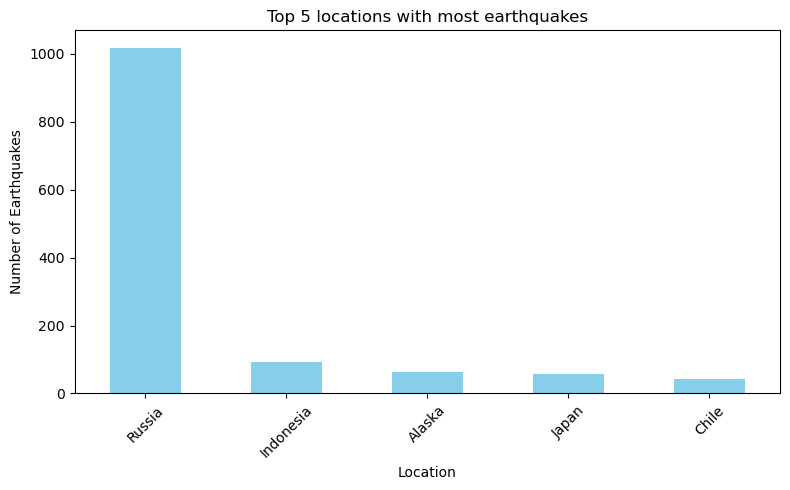
Plot a Histogram of Earthquake Magnitudes¶
[16]:
fig, ax = plt.subplots(figsize=(8,5))
ax.hist(df_mag4['mag'],bins=20,color='orange',edgecolor='black')
ax.set_title('Distribution of earthquakes >= 4.0')
ax.set_xlabel('Magnitude')
ax.set_ylabel('Count')
ax.grid(axis='y',linestyle='--')
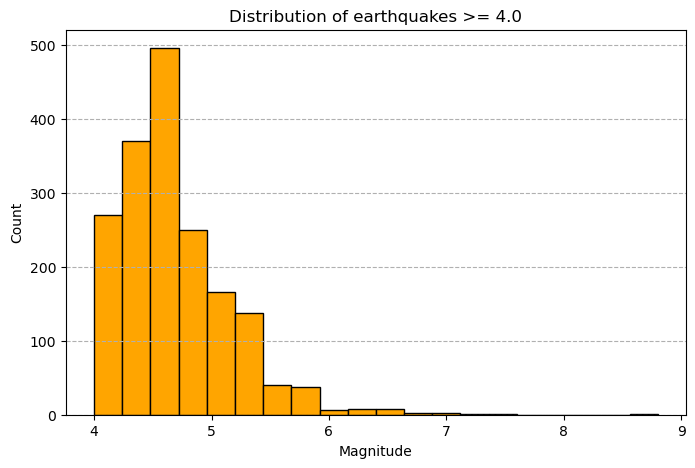
Plot a Histogram From Both Datasets with Log Axis¶
[17]:
fig, ax = plt.subplots(1,2,figsize=(10,5))
ax[0].hist(df['mag'],bins=20,color='skyblue',edgecolor='black')
ax[0].set_title('Distribution of earthquakes')
ax[0].set_xlabel('Magnitude')
ax[0].set_ylabel('Count')
ax[0].grid(axis='y',linestyle='--')
ax[0].set_yscale('log')
ax[1].hist(df_mag4['mag'],bins=20,color='orange',edgecolor='black')
ax[1].set_title('Distribution of earthquakes >= 4.0')
ax[1].set_xlabel('Magnitude')
ax[1].set_ylabel('Count')
ax[1].grid(axis='y',linestyle='--')
ax[1].set_yscale('log')
plt.tight_layout()
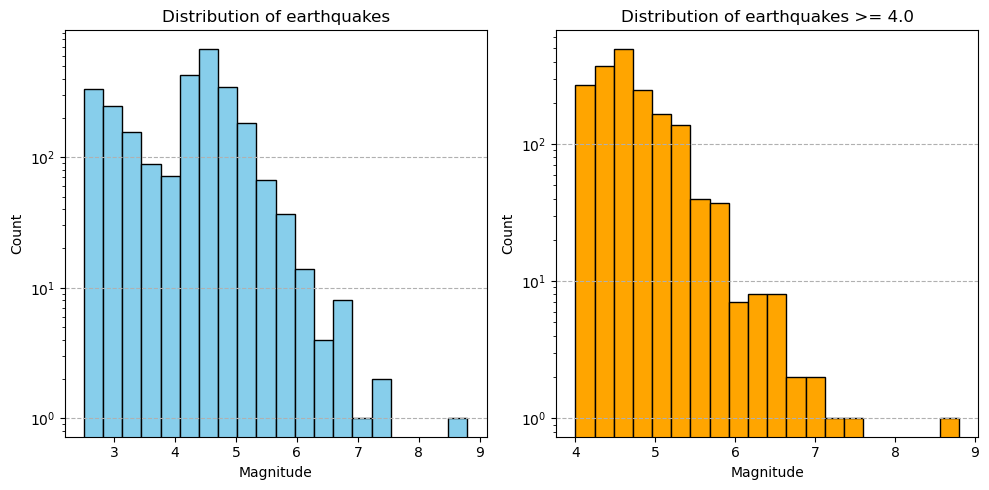
Scatter Plot of Earthquake Locations¶
[18]:
fig, ax = plt.subplots(figsize=(8,5))
ax.scatter(df['longitude'],df['latitude'],s=10, alpha=0.6,c='red',edgecolors='black')
ax.set_xlabel('longitude')
ax.set_ylabel('latitude')
ax.grid(True)
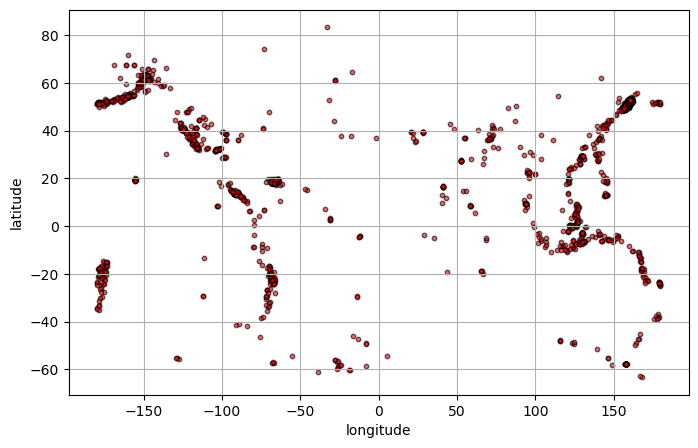
Add a Map to Scatter with Cartopy¶
[19]:
import cartopy.crs as ccrs
import cartopy.feature as cfeature
# Create a GeoAxes with PlateCarree projection (standard lat/lon)
fig = plt.figure(figsize=(12,10))
ax = plt.axes(projection=ccrs.PlateCarree())
# Add coastlines and land features
ax.coastlines(resolution='110m')
ax.add_feature(cfeature.LAND, facecolor='lightgray')
ax.add_feature(cfeature.OCEAN, facecolor='lightblue')
# Scatter earthquake points
ax.scatter(df['longitude'], df['latitude'], s=10, c='red', alpha=0.6,
edgecolors='k', linewidth=0.3, transform=ccrs.PlateCarree())
# Add gridlines with labels
gl = ax.gridlines(draw_labels=True, linewidth=0.5, color='gray', alpha=0.5, linestyle='--')
gl.top_labels = False
gl.right_labels = False
ax.set_title('Earthquake Locations with Coastlines')
plt.show()
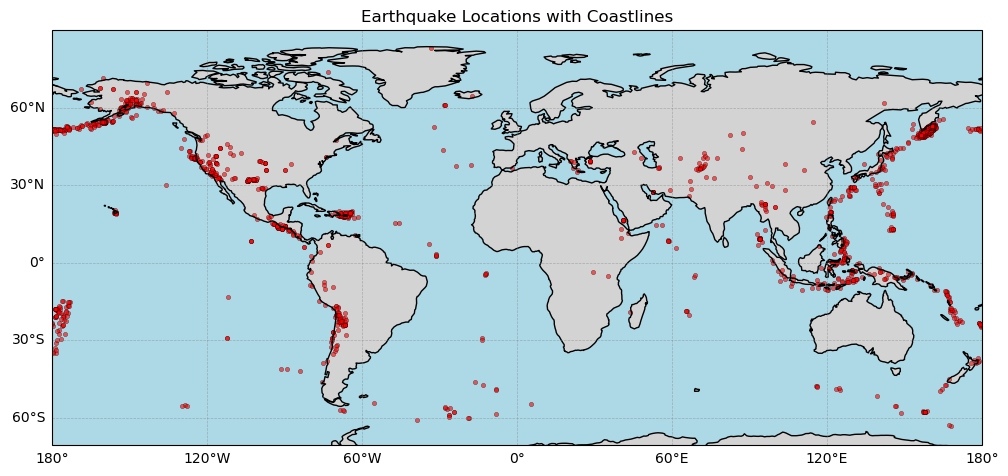
Exercises¶
Update the scatter plot, such that the color of each dot reflects the magnitude of the earthquake.
Same idea as option (1), but make the size of each dot reflect the magnitude of the earthquake.
Create a new table that only contains earthquakes from Russia. Investigate the distribution of earthquake magnitudes in Russia in the last 30 days. Plot just the relevant region, and include some coloring or sizing of the scatter to highlight the biggest earthquakes.
Content for this tutorial was inspired by following an assignment from the Earth and Environmental Science Databook. The assignment can be found here.